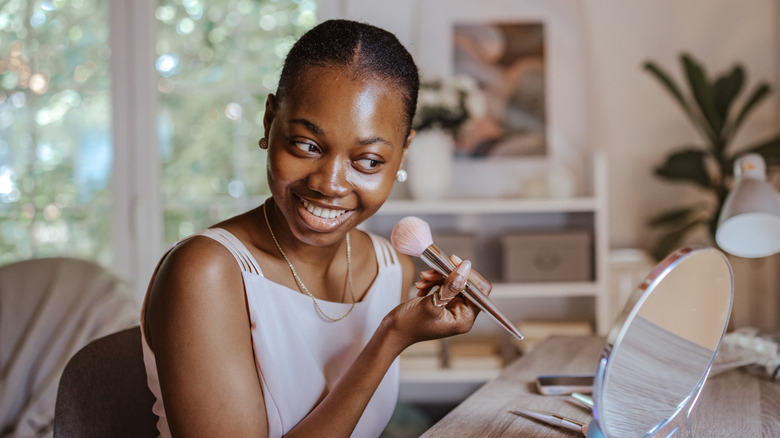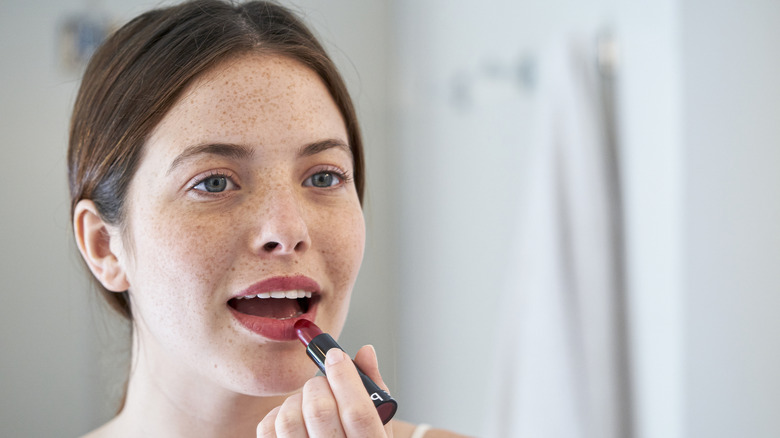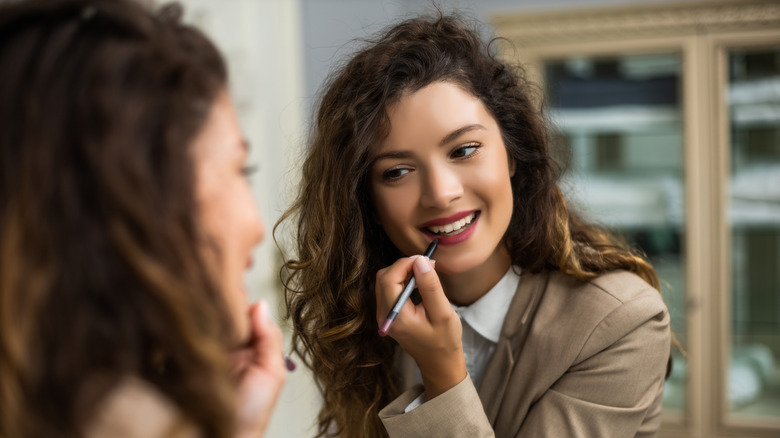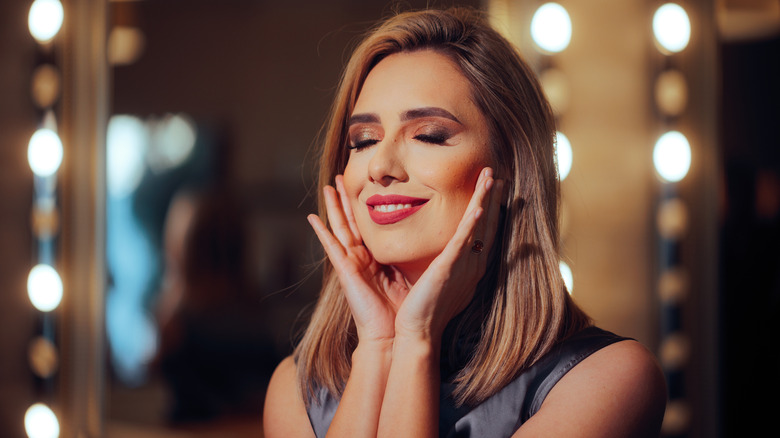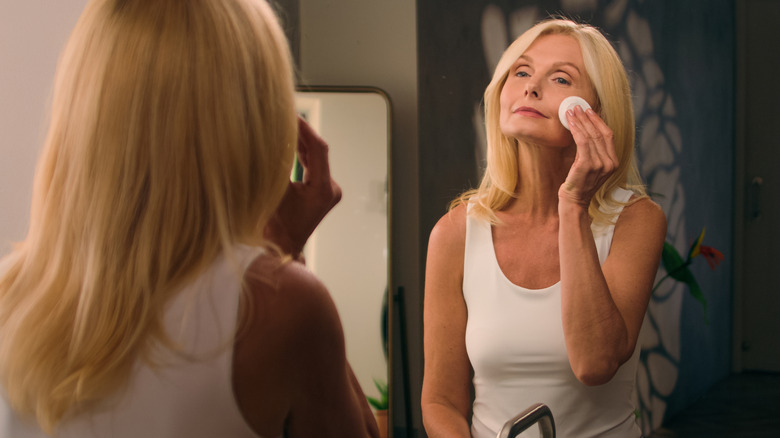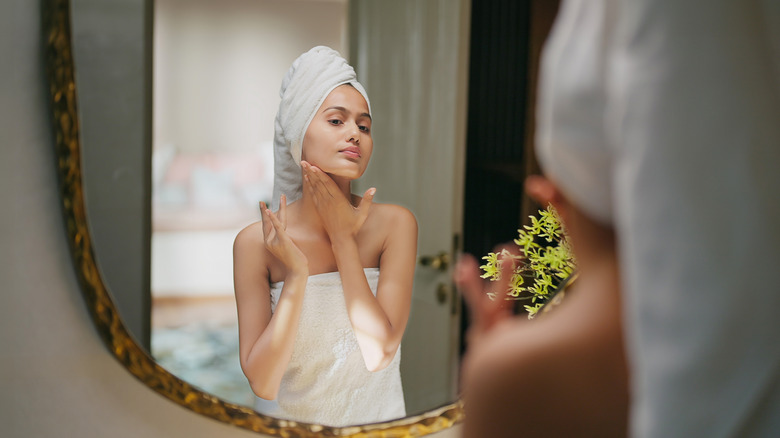Our Makeup Artist Tells Us 5 Beauty Rules That Are Made To Be Broken
We may receive a commission on purchases made from links.
There are certain rules we've all learned about proper makeup application — whether it was from perusing beauty magazines, watching our parents get ready, or simply by trial and error. Advice such as matching blush with our lipstick or never wearing full-coverage foundation in the summer may have been imbedded into our memories, and now many of us live by this guidance. However, we here at Glam think that rules are made to be broken, especially when it comes to putting on our faces.
As a longtime makeup artist with over a decade of experience, I do have to follow some hard and fast rules. For example, I always match the clients' foundation to their necks and chests, and I never skip eyebrows. With that being said, not everyone wears a full face of makeup every day and you can wear as little or as much as you please, however you want. Go rogue with the makeup rules because, as is the case with the following five adages, they can certainly become outdated.
Focusing on only one feature isn't mandatory
The demure way of applying makeup used to be focusing on either the eyes or the lips, but never both at the same time. The rule was to either go for smokey eyes and nude lips or bold lipstick paired with subtle eyeshadow to balance out the makeup. Well, this is one instruction you can throw out the window. There is nothing wrong with going all-in with your look, especially if you love a beat face. Smokey eyes and strong lips are totally fierce and sexy, as long as you don't go overboard with the products.
My advice for choosing to bring out both your eyes and lips is to plan out your look before you apply your makeup. I love creating the sharpest cat-eye ever using TikTok's segmented liner hack and combining it with classic red lipstick. With this look, I suggest keeping your lids bare or adding just a touch of bronze or taupe eyeshadow. If you're going for a smokey eye, an alluring shade of burgundy lipstick would look totally vampy. There are countless combinations to go for and none of them are wrong, so rock your full face of makeup any way you want.
Your lip liner doesn't really need to match your lipstick
Using a too-dark lip liner is a trend that I was never a fan of, especially when the line is drawn super sharp and pronounced. That doesn't mean that I always match the liner exactly to the lipstick, however. Using a slightly darker lip liner is perfectly acceptable and actually gives your pout a beautiful 3D effect. As long as your liner and lipstick shades are in the same color family and they're both warm or cool, they'll complement each other.
To make your lips look naturally plump, I suggest using a liner about two shades darker than your lipstick. Make an outline just slightly outside of your natural line and feather in the color along the outside corners of your lips, stopping short of the middle. Then, apply your lipstick onto the center of your lips and blend it toward the darker shade, being sure not to overlap too much. The outcome should be a seamless gradient effect that brings out your lips without an obvious outline.
Saving the smokey eyes for nighttime isn't necessary
You've probably heard the terms "daytime makeup" and "nighttime makeup," but let's normalize wearing smokey eyes any time we want. Want to vamp up your eyes for the office or brunch with friends? Pile on the eyeshadow! Smokey eyes are perfectly acceptable during the day and if you master your blending skills, they can look subtle enough even for work. There are so many variations of smokey eyes, and one of my favorite looks is with bronze and chocolate-brown shades. If you're nervous about intensifying your eyes during the daytime, stick with neutrals and you'll get a gorgeous sultry effect without it being too excessive.
Some even say that smokey eyes shouldn't be worn in the summer, as it's too intense for the hot weather, but I think it's the perfect season for a combo of sea-foam green and electric blue. Smokey eyes don't have to just be all about using blacks, grays, and browns. Play around with different colors and you'll see how many admiring looks you get with your daytime smokey eye.
Actually, you don't have to set your face with powder
For decades, we've been taught that the final step in applying makeup is to set your face with powder. This rings true for many, especially if they have oily skin or want to avoid creasing on the lids or around fine lines. When I'm working on brides or for a video presentation during corporate shoots, setting powder is a must for my clients, as the makeup needs to last long and hold up under hot lights. However, when it comes to everyday makeup or even for your going-out look, powder isn't always necessary.
If you want to go for pearl skin, which is the next evolution of the glass skin makeup trend, or if you simply have dry skin, you can skip powder and use a setting spray instead. There are plenty of options that leave your skin looking hydrated, like Milani's Make It Last Dewy Finish Setting Spray that's under $10, at the time of writing. For a splurge, try the Charlotte Tilbury Airbrush Flawless Setting Spray that's $60 but comes in a set of two. You may still need to address certain areas with some powder before the setting spray, especially if your eye makeup tends to smudge. I like to dab a bit of invisible powder right under the outer corners of my eyes to help soak up any excess sebum. Additionally, if you have an oily T-zone, I would recommend dusting some powder onto your forehead, nose, and chin but you can skip the rest of your face to keep that natural glow.
There is a certain order of applying makeup - but you can break this rule
When learning how to apply makeup, it's certainly helpful to have a step-by-step guide: skincare, concealer, foundation, eye makeup, blush, lipstick, and powder, in that order. However, once you get the hang of things, there's no rule that states you have to keep up with the same regimen. Instead, tailor the order of products you apply to your needs. If doing up your eyes is not your strong suit, start with that area first. In fact, applying eye makeup first is a trick many makeup artists use to save time and avoid having to clean up the fallout from shadow. Just be sure to prime your lids with either an eye primer or concealer first. After your eye makeup is complete, you can move on to the rest of your face.
There's a big debate on whether concealer or foundation comes first and it all depends on what you're trying to achieve. If you need to cover up a blemish, I suggest using a green color-correcting concealer (and you can read about this product in our guide to color-correcting concealers) to get rid of any redness and apply foundation as normal. Then, if you still see the pimple peeking through, dot on a bit of your regular concealer. When it comes to dark circles, I like to apply concealer first and then blend the foundation in so that there is no distinction between the two. See what order suits you and your style of makeup, and you'll soon have a makeup routine that's best for you because as we know, it's not one-size-fits-all.
